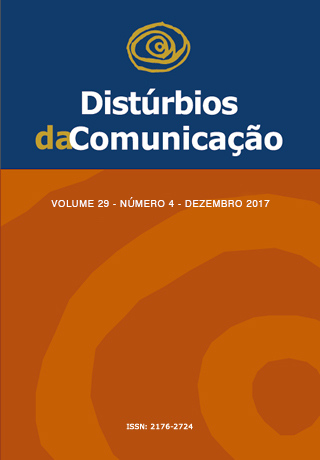Efetividade na adesão a reabilitação auditiva em crianças: Grupo de Adesão Familiar e terapia inicial
DOI:
https://doi.org/10.23925/2176-2724.2017v29i4p734-748Palavras-chave:
Audição, Perda de audição, Auxiliares da audição, Prática de grupo e Terapia narrativaResumo
Introdução: O diagnóstico precoce da deficiência auditiva em crianças e a intervenção são determinantes para o desenvolvimento. Uso do AASI; expectativas dos familiares e sua implicação com o tratamento são fatores importantes para o prognóstico. Objetivo: O objetivo foi verificar a efetividade da adesão à reabilitação auditiva, a consistência de uso do AASI, a participação nas terapias e nos grupo na fase inicial do processo terapêutico (ADAPTI), num serviço da Rede Municipal de Saúde de São Paulo. Método: A pesquisa foi realizada em crianças com deficiência auditiva atendidas em um serviço da Rede Municipal, seus responsáveis e terapeutas. Este estudo teve caráter descritivo quanti/qualitativo. Caracterizamos os sujeitos do ponto de vista demográfico, audiológico, da consistência de uso do AASI e da efetividade na adesão. Resultados: As 25 crianças foram organizadas em cinco grupos. Dessas, 13 eram do gênero feminino e 12 do masculino. Vinte e quatro tinham perda auditiva sensorioneural. Uma tinha perda condutiva com AASI adaptado com vibrador ósseo. Dez tinham suspeita/presença de outros comprometimentos. Os classificamos conforme o desfecho do ADAPTI. Diferentes prognósticos interferiram nas orientações, desinteressando os pais com demandas diferentes. Discussão: O grupo de Apoio Familiar (GrAF) foi um facilitador no processo. Grupos mais homogêneos levam maior empatia entre os participantes e maior probabilidade de adesão. A distância e o SII 65 dB são fatores que parecem afetar a adesão. Conclusão: Grupos homogêneos propiciaram maior adesão; As atividades propiciaram discussões que promovem adesão ao tratamento; O GrAF foi considerado um facilitador. A distância e o SII 65 dB parecem afetar a adesão.Downloads
Não há dados estatísticos.
Downloads
Publicado
2017-12-27
Edição
Seção
Artigos
Licença
Copyright (c) 2017 Bruna Capalbo Youssef, Beatriz de Castro Andrade Mendes, Eliane de Carvalho e Costa, Luisa Barzaghi Ficker, Beatriz Cavalcanti de Albuquerque Caiuby Novaes

Este trabalho está licenciado sob uma licença Creative Commons Attribution 4.0 International License.









